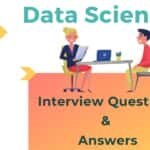We are living in a world where data drives decisions. Also, it is making transformative changes across the business nations. Data manipulation in Data Science is the fundamental process in data analysis. It helps in extracting meaningful insights that help in meeting specific organisational goals. The data professionals deploy different techniques and operations to derive valuable information from the raw and unstructured data. The objective is to enhance the data quality and prepare the data sets for the analysis.
Table of Contents
ToggleWhat is Data Manipulation?
Data Manipulation in data science is a crucial step that helps in unfolding patterns that eventually help make informed decisions. In simple words, it refers to modifying, transforming, or reorganizing data to extract meaningful insights, prepare it for analysis, or meet specific requirements. Moreover, it also enables data professionals to get a deeper insight into complex datasets. Furthermore, with the ability to manipulate data efficiently, companies can unlock their true potential, which can eventually help in boosting their productivity and gain a competitive edge.
Since data manipulation in data science has become integral for organisations, in this blog, we have focused on discussing its key features and data manipulation examples that will help you understand the significance of this technique.
Key Features of Data Manipulation
- Data Filtering
Filtering of data is an integral aspect of data manipulation. It helps in extracting relevant and valuable information from the raw data.
- Data Sorting
Sorting data or organising the data into columns and rows can help in presenting the data in a more structured manner. Does it help in simplifying the analysis process?
- Data Aggregation
Combining multiple records into a single summary is another significant feature of data manipulation in data science. The aggregation includes functions like average, summation, accounting and finding the maximum or minimum values.
- Data Transformation
This feature lets you transform data by applying mathematical operations, conversions, or manipulations. For example, you can convert data types, standardize units, normalize data, or perform calculations.
- Data Joining and Merging
Data manipulation allows you to combine data from multiple sources or tables by joining them based on standard fields or keys. Moreover, this feature helps integrate data sets to gain a more comprehensive view or perform complex analyses.
Data manipulation provides tools to clean and preprocess data. It works by correcting errors, removing duplicates, and dealing with outliers. Thus, Cleaning data ensures data quality and enhances the accuracy of analyses.
- Data Reshaping
You can reshape data using pivoting, melting, or transposing techniques. These operations restructure the data to convert it from one format to another, making it suitable for specific analysis requirements or visualizations.
- Data Calculation and Derivation
Data manipulation allows you to create new calculated columns or derived variables based on existing data. This feature enables you to perform calculations, apply formulas, or generate new insights from the available data.
It provides powerful tools and techniques to manipulate, organize, and transform data, allowing for efficient data analysis and decision-making processes.
Data Manipulation Examples
Data manipulation encompasses a wide range of operations that can be performed on data. Let’s explore some common examples to understand how it works in practice:
Example 1: Filtering and Sorting
One fundamental data manipulation task is filtering and sorting. This involves selecting specific rows or columns based on certain criteria and arranging the data in order. For instance, in a customer database, you might filter the records only to include customers who purchased in the last month and then sort them based on their total spending.
Example 2: Aggregation and Summarization
Another essential aspect of data manipulation is aggregating and summarizing data. This involves calculating summary statistics, such as a specific variable’s average, sum, minimum, or maximum values. For instance, in sales data, you might aggregate the total revenue generated per product category or calculate the monthly average sales.
Example 3: Joining and Merging
Data manipulation also combines data from multiple sources by joining and merging operations. This allows you to consolidate information from different datasets into a unified view. For example, in an e-commerce setting, you might merge customer data with order data to gain insights into customer behaviour and preferences.
Advantages of Data Manipulation
Effective data manipulation offers several advantages that contribute to better data analysis and decision-making:
Improved Data Quality
Data manipulation techniques enable you to clean and transform raw data into a more refined and usable format. By removing inconsistencies, errors, and duplicates, you enhance the quality and reliability of the data, leading to more accurate analyses and insights.
Enhanced Data Exploration
Manipulating data allows you to explore and examine the information from different angles. By filtering, sorting, and summarizing the data, you can quickly identify patterns, trends, and outliers, enabling deeper exploration and understanding of the underlying phenomena.
Customized Data Presentation
Data manipulation provides the flexibility to tailor the presentation of data according to specific requirements. You can aggregate and summarize data in various ways, create custom reports and visualizations, and highlight the most relevant insights, making it easier for stakeholders to comprehend and make informed decisions.
Efficient Decision-Making
By manipulating data effectively, you can extract valuable insights quickly, enabling timely and informed decision-making. Whether it’s identifying market trends, optimizing business processes, or targeting customer segments, data manipulation is vital in driving strategic actions and achieving desired outcomes.
Types of Data Manipulation
Data manipulation techniques can be categorized into different types based on the operations performed. Let’s explore some common types of data manipulation:
1. Data Cleaning
Data cleaning involves identifying and rectifying dataset errors, inconsistencies, and missing values. This process ensures data accuracy and integrity by removing or correcting problematic entries, standardizing formats, and resolving inconsistencies.
2. Data Transformation
Data transformation refers to converting data from one format or structure to another. It involves normalization, scaling, encoding, or converting data types to facilitate analysis and improve compatibility with different systems or models.
3. Data Aggregation
Data Aggregation combines individual data points into groups or summaries. It involves operations like calculating totals, averages, or percentages across specific dimensions or categories, providing a high-level view of the data.
4. Data Enrichment
Data enrichment involves enhancing existing data by adding additional information from external sources. This can include appending demographic, geographic, or social media data to enrich the existing dataset and gain deeper insights.
Data Manipulation vs. Data Modification
While data manipulation and data modification may sound similar, they have distinct meanings in the context of data management:
Data manipulation refers to transforming and organizing data to facilitate analysis and decision-making. As discussed earlier, it involves operations like filtering, sorting, summarizing, joining, and aggregating data.
On the other hand, data modification refers to altering the structure or schema of a database. It involves changing the database’s structure, such as adding or deleting tables, modifying column definitions, or altering relationships between tables.
Both data manipulation and Data Modification are important in data management, but they serve different purposes and address different aspects of working with data.
Tabular Representation of Data Manipulation vs Data Modification
| Data Manipulation | Data Modification |
| Involves modifying, transforming, or reorganizing data to extract insights or prepare it for analysis. | Involves making direct changes to the data itself, altering its original values. |
| Focuses on data transformations, filtering, sorting, aggregation, joining, cleaning, reshaping, and calculations. | Focuses on updating, inserting, or deleting data records within a dataset or database. |
| Does not alter the original data; instead, it creates new representations or summaries of the data. | Alters the original data by directly modifying its values or structure. |
| Primarily used for data analysis, data preparation, and data exploration purposes. | Primarily used for data management, database maintenance, and data persistence purposes. |
| Examples include filtering data based on criteria, aggregating data to compute summary statistics, joining datasets based on common keys, and transforming data formats. | Examples include updating a customer’s address, inserting new records into a database table, or deleting obsolete data entries. |
| Data manipulation operations are often reversible and do not permanently change the original data. | Data modification operations directly modify the original data and can be irreversible if not carefully managed. |
It’s important to note that while these two concepts are distinct, they can be interconnected in certain scenarios. Data manipulation may involve temporary modifications for analysis purposes, but it typically focuses on creating derived representations of the data rather than permanently changing it. On the other hand, data modification involves direct and permanent changes to the data itself.
Data Manipulation Tools
Various tools and technologies are available to facilitate data manipulation tasks. Let’s explore some popular tools widely used in the industry:
1. SQL (Structured Query Language)
SQL is a standard language for managing relational databases. Also, it provides powerful commands for querying, filtering, sorting, and aggregating data. SQL is commonly used for data manipulation tasks, especially with structured datasets.
2. Python and R
Programming languages like Python and R offer rich libraries and frameworks for data manipulation. Moreover, libraries such as Pandas in Python and dplyr in R provide intuitive and efficient functions for performing various data manipulation operations. And so, these languages are widely used in data science and analytics workflows.
3. Excel
Excel is a popular spreadsheet software that also offers basic data manipulation capabilities. Besides, it allows users to filter and sort data, perform calculations, and create simple visualizations. While Excel is not as powerful as specialized data manipulation tools, it is widely accessible and user-friendly.
4. Business Intelligence (BI) Tools
BI tools like Tableau, Power BI, and QlikView provide comprehensive data manipulation features and advanced visualization capabilities. These tools enable users to connect to various data sources, manipulate and transform data visually, and create interactive dashboards and reports.
Conclusion
Since, Data Manipulation empowers individuals and organizations to extract valuable insights, improve data quality, and drive informed actions, it has become a unique skill set. Moreover, by understanding the various techniques, examples, advantages, and tools associated with data manipulation, you can harness its power to unlock the true potential of your data.
In this article, we have discussed some of the key aspects of Data Manipulation that will help you harness this technique for accurate data analysis.
Now that you have a comprehensive understanding of data manipulation, it’s time to apply these insights in practice and leverage the power of data to gain a competitive edge in your field.
Frequently Asked Questions
Data manipulation is crucial for several reasons. It allows analysts and professionals to extract relevant information from raw data, enhance data quality, and prepare datasets for analysis. By manipulating data effectively, organizations can derive valuable insights, make informed decisions, and gain a deeper understanding of their data.
Depending on the specific requirements and context, various tools and technologies are available for data manipulation. Commonly used tools include SQL (Structured Query Language) for database operations, programming languages like Python or R with libraries such as Pandas or dplyr, spreadsheet software like Microsoft Excel or Google Sheets, and data manipulation frameworks like Apache Spark.
Common data manipulation operations include filtering data to extract specific subsets, sorting data based on variables or columns, aggregating data to compute summaries, joining datasets based on common keys, cleaning data by handling missing values or outliers, reshaping data to convert it from one format to another, and performing calculations or deriving new variables from existing data.
Data manipulation creates new representations or summaries of the data without permanently changing the original data. However, it depends on how the operations are performed and whether the original data is preserved or backed up.
Data manipulation is a critical step in data analysis. However, before going ahead with the analysis step, it is integral to prepare the data. Thus, Data Manipulation comes into the picture. It cleanses the data and certifies it to be fit for analysis.
Yes, there are several best practices for data manipulation. Here are a few of them:
- Document everything
- Use appropriate data structures
- Handle missing values and outliers carefully
- Validate and verify the results
- Ensure data integrity and security
- Use version control
- Work in collaboration











